|
 Image #1 Packing Heat … If you have been keeping up with the past 5 month’s of WATR articles you should have a pretty good idea of what equipment and lighting gear I will be using for this project. My Nikon D3s, Nikon lenses and Nikon SB-900 Speedlights with Nikon SU-800 Commander are a given. Next comes the FourSquare Block and Hand Grip that will support 4 Speedlights, and a second FourSquare Block will also be connected to the hand grip so as to have the capability of supporting 8 Speedlights. All Speedlights are in the Remote mode. All Speedlights are at a Manual setting of Full Power unless otherwise stated in the camera data. I use the wireless Radio Popper PX transmitter and receiver system to fire my Speedlights when they are located off camera. The PX system allows me to use the Nikon camera’s Custom Setting of Auto FP High Speed Sync. Nikon’s custom setting of Auto FP High Speed Sync allows me to use fast shutter sync speeds above 1/250 of a second which is key when shooting sports action. And I use the Michael Bass Designs (MBD) Fiber Optic Bundles which are connected between the Radio Popper PX receiver and Speedlight sensor. The MBD Bundles guarantee perfect transmission of the radio signal from my Radio Popper PX system in bright sunlit conditions. Here is my pre-assembled EightSquare of Speedlights secured into my backpack for the hike up the mountain. Image #1 Packing Heat … If you have been keeping up with the past 5 month’s of WATR articles you should have a pretty good idea of what equipment and lighting gear I will be using for this project. My Nikon D3s, Nikon lenses and Nikon SB-900 Speedlights with Nikon SU-800 Commander are a given. Next comes the FourSquare Block and Hand Grip that will support 4 Speedlights, and a second FourSquare Block will also be connected to the hand grip so as to have the capability of supporting 8 Speedlights. All Speedlights are in the Remote mode. All Speedlights are at a Manual setting of Full Power unless otherwise stated in the camera data. I use the wireless Radio Popper PX transmitter and receiver system to fire my Speedlights when they are located off camera. The PX system allows me to use the Nikon camera’s Custom Setting of Auto FP High Speed Sync. Nikon’s custom setting of Auto FP High Speed Sync allows me to use fast shutter sync speeds above 1/250 of a second which is key when shooting sports action. And I use the Michael Bass Designs (MBD) Fiber Optic Bundles which are connected between the Radio Popper PX receiver and Speedlight sensor. The MBD Bundles guarantee perfect transmission of the radio signal from my Radio Popper PX system in bright sunlit conditions. Here is my pre-assembled EightSquare of Speedlights secured into my backpack for the hike up the mountain.
|
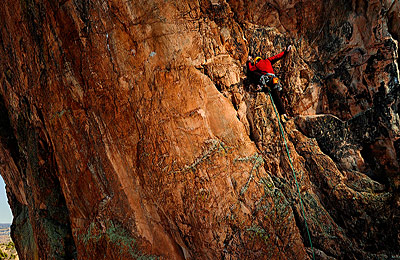 Image #2A Light Climber… First and foremost, I wanted to see just how far I could throw light in midday open shade conditions. The answer is 85 feet, give or take a few. It took 8 Speedlights mounted to 2 FourSquare Blocks that are connected to the FourSquare Hand Grip, the EightSquare as I call it. Chris is about 85 feet away from the EightSquare of Speedlights. I’ve scrambled up onto an outcropping of rock and am directly across from Chris about 50 feet away. This places me about 85 feet from my Speedlights and forms a triangle with the three points being Chris, my Speedlights and myself. This triangle arrangement is quite common when using a single off camera light source. In this case, the EightSquare is my single light source. I have intentionally underexposed the scene by about –1.3 stop and then had the light from my Speedlights illuminate Chris and the rock face from the side. This sidelight helps reveal the deep contours of the rock face, which adds drama to the scene. A test shot shows me where the “shaft of Speedlight” is and so I tell Chris to choose a route that runs through the lit area. Nikon D3s, ISO1000, 1/1000 at f8.0, Nikon 24-70mm lens, WB 7140K, 8 Nikon SB-900 Speedlights, 2 FourSquare Blocks with Hand Grip (EightSquare), Radio Popper PX system, MBD Fiber Optic Bundles, Nikon SU-800 Commander, Gitzo Monopod to support the EightSquare, Lexar 16G Flash Card. Image #2A Light Climber… First and foremost, I wanted to see just how far I could throw light in midday open shade conditions. The answer is 85 feet, give or take a few. It took 8 Speedlights mounted to 2 FourSquare Blocks that are connected to the FourSquare Hand Grip, the EightSquare as I call it. Chris is about 85 feet away from the EightSquare of Speedlights. I’ve scrambled up onto an outcropping of rock and am directly across from Chris about 50 feet away. This places me about 85 feet from my Speedlights and forms a triangle with the three points being Chris, my Speedlights and myself. This triangle arrangement is quite common when using a single off camera light source. In this case, the EightSquare is my single light source. I have intentionally underexposed the scene by about –1.3 stop and then had the light from my Speedlights illuminate Chris and the rock face from the side. This sidelight helps reveal the deep contours of the rock face, which adds drama to the scene. A test shot shows me where the “shaft of Speedlight” is and so I tell Chris to choose a route that runs through the lit area. Nikon D3s, ISO1000, 1/1000 at f8.0, Nikon 24-70mm lens, WB 7140K, 8 Nikon SB-900 Speedlights, 2 FourSquare Blocks with Hand Grip (EightSquare), Radio Popper PX system, MBD Fiber Optic Bundles, Nikon SU-800 Commander, Gitzo Monopod to support the EightSquare, Lexar 16G Flash Card.
|

Image #2B Light Climber Set-Up … This is a 3 frame “stitched” image that illustrates were the EightSquare of 8 Speedlights is located and the ambient light conditions we were working with. The far left side of the image is looking South while the far right is looking North, making this a 180 degree panorama. I feel it is important to have the light angling down towards my subject and so Brad has hiked/scrambled up the North ridge and gotten slightly higher than Chris and adjacent to the face of the wall. Neither Brad nor I are technical climbers. We took some time scouting the area a day earlier to find a suitable location that enabled the three of us to get into the triangle lighting arrangement of subject, Speedlights, and photographer. If you go back and read the past few months of articles featuring Sports Action with Speedlights you will notice that this triangle lighting arrangement is common with my single light source off camera lighting. All the same gear and exposure data was used for this image as with image #2A, with the exception of using a Nikon 14-24mm lens at 14mm to capture 3 horizontal frames and then “stitching” them together in Photoshop to form the 180 degree panorama.
|
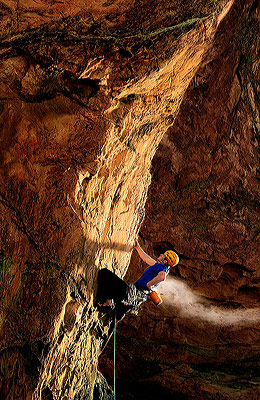 Image #3 Wind Chalker … This image was made in a different open shade location, but the concept of slightly underexposing the scene and using the triangle lighting arrangement with the 3 points being subject, Speedlights, and myself is the same. Brad is holding the EightSquare of Speedlights about 55 feet away from Chris’s back. Again I made use of an open shade location and slightly underexposed the scene by about –1.3 stop and then added light from my 8 Speedlights to strike Chris and the edge of the rock face from a side angle. In fact it is so sidelit that Chris is slightly backlit. We were contending with 35mph wind gusts that day so I asked him to pull out a handful of chalk from his chalk pouch which sent a cloud of chalk riding on the wind. By slightly backlighting Chris the wind blown chalk is easier to see. Also, the bounce of light off the rock fills his face with reflected light, nice, a win-win situation. Nikon D3s, ISO1000, 1/1000 at f8, Nikon 70-200mm G VR II zoom lens, WB 7140K, EightSquare, Radio PX, MBD Bundles, Nikon SU-800 Commander, Gitzo Monopod, Lexar 16G Flash Card. Image #3 Wind Chalker … This image was made in a different open shade location, but the concept of slightly underexposing the scene and using the triangle lighting arrangement with the 3 points being subject, Speedlights, and myself is the same. Brad is holding the EightSquare of Speedlights about 55 feet away from Chris’s back. Again I made use of an open shade location and slightly underexposed the scene by about –1.3 stop and then added light from my 8 Speedlights to strike Chris and the edge of the rock face from a side angle. In fact it is so sidelit that Chris is slightly backlit. We were contending with 35mph wind gusts that day so I asked him to pull out a handful of chalk from his chalk pouch which sent a cloud of chalk riding on the wind. By slightly backlighting Chris the wind blown chalk is easier to see. Also, the bounce of light off the rock fills his face with reflected light, nice, a win-win situation. Nikon D3s, ISO1000, 1/1000 at f8, Nikon 70-200mm G VR II zoom lens, WB 7140K, EightSquare, Radio PX, MBD Bundles, Nikon SU-800 Commander, Gitzo Monopod, Lexar 16G Flash Card. |
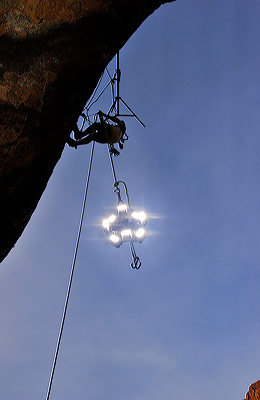 Image #4A Sky Walker Gear Ascent … Sometimes to produce a unique image the photographer must go to some extreme measures to get what they want. For the next series of images I felt I needed Keith’s direct input and so I drove further West to the town of St. George, Utah. I met up with Keith and was brimming over with confidence from my solo Speedlighting shoot in Colorado. I began sharing with him the kind of image I had been envisioning in my mind and asked if he could help out. He said he knew of some locations that might work well and after a day of site surveying we settled on a remote area in the Black and Tan region. This shoot would require a technical climber for an assistant and Keith teamed me up with Taylor who wasted no time in getting my EightSquare of Speedlights into position. Image #4A Sky Walker Gear Ascent … Sometimes to produce a unique image the photographer must go to some extreme measures to get what they want. For the next series of images I felt I needed Keith’s direct input and so I drove further West to the town of St. George, Utah. I met up with Keith and was brimming over with confidence from my solo Speedlighting shoot in Colorado. I began sharing with him the kind of image I had been envisioning in my mind and asked if he could help out. He said he knew of some locations that might work well and after a day of site surveying we settled on a remote area in the Black and Tan region. This shoot would require a technical climber for an assistant and Keith teamed me up with Taylor who wasted no time in getting my EightSquare of Speedlights into position. |
|
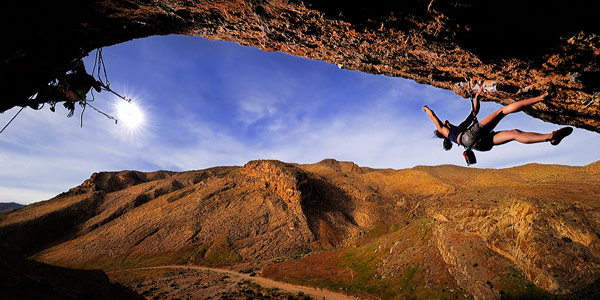
Image #4B Sky Walker Set-Up … The image I envisioned was a steep inverted climb with sunlit mountains in the background. The Speedlights would reveal my athlete from a shaded silhouette and illuminate them to closely match the sunlit mountains in the background. This image illustrates the triangle lighting arrangement with Taylor’s off camera lighting location, my athlete, and my shooting position as the 3 points of the triangle lighting arrangement. |
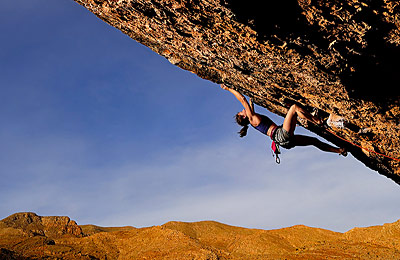 Image #4C Sky Walker … As Col. John “Hannibal” Smith from the A-Team used to say, “I love it when a plan comes together.” Keep in mind this plan came together thanks to Keith and his expertise in both climbing and photography and the superior athletic skills of one of the nations top climbers, and Utah’s favorite daughter, Lauren Lee. Lauren’s climbing speed and graceful athletic style were impressive to say the least. The off camera lighting reveals Lauren and accentuates the rugged texture of the rock and inverted climbing route. An added piece of equipment for this unique image was a 1stop Graduated Neutral density Filter that reduced some of the exposure on the sunlit mountains in the background. Nikon D3s, ISO640, 1/1000 at f8, Nikon 24-70mm, WB 6670K, EightSquare with 8 Nikon SB-900 Speedlights mounted to a lightstand acting as a boom-arm extending from the rock face, Radio PX system, MBD Bundles, Nikon SU-800 Commander, FORMATT 1 stop Graduated Neutral Density Filter, Lexar 16G Flash Card. Image #4C Sky Walker … As Col. John “Hannibal” Smith from the A-Team used to say, “I love it when a plan comes together.” Keep in mind this plan came together thanks to Keith and his expertise in both climbing and photography and the superior athletic skills of one of the nations top climbers, and Utah’s favorite daughter, Lauren Lee. Lauren’s climbing speed and graceful athletic style were impressive to say the least. The off camera lighting reveals Lauren and accentuates the rugged texture of the rock and inverted climbing route. An added piece of equipment for this unique image was a 1stop Graduated Neutral density Filter that reduced some of the exposure on the sunlit mountains in the background. Nikon D3s, ISO640, 1/1000 at f8, Nikon 24-70mm, WB 6670K, EightSquare with 8 Nikon SB-900 Speedlights mounted to a lightstand acting as a boom-arm extending from the rock face, Radio PX system, MBD Bundles, Nikon SU-800 Commander, FORMATT 1 stop Graduated Neutral Density Filter, Lexar 16G Flash Card. |
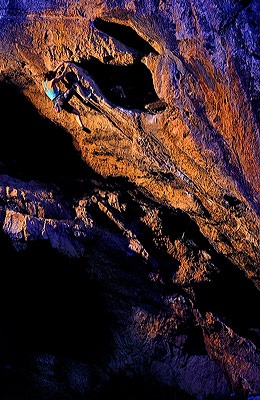 Image #5A Utah Ascent … This final shoot came as a result of the site survey Keith and I made the day before. This gnarly area of cracks, crevasses, and a huge wall with gaping holes would be perfect, especially with the Moody Blue formula of cool-blue WB and warming gelled Speedlights. As is my style, I manually underexposed the available ambient light, this time by –2.0 stops because I wanted the light from my 4 Speedlights with warming gels to dominate the scene rather than fill it. The sun had just set and twilight was beginning when Lauren started her ascent of this rugged dynamic face. The cool blue White Balance of 4000K combined with the warming-gelled light from only 4 SB-900 Speedlights mounted to a single FourSquare with Hand Grip provided a hard edge of light that revealed Lauren and the deep contours of her ascent route. I had Taylor tilt and angle the FourSquare of Speedlights about 20 inches one way and then another in an effort to cast different shadows and create a variety of pockets of light with each of Lauren’s new hand and foot placements. Each picture I made looked better than the last until she made a dynamic move around this hole. I love this picture. Nikon D3s, ISO2500, 1/320 at f4.5, Nikon 70-200mm G VR II zoom lens, WB 4000K, 4 Nikon SB-900 Speedlights each with a warming gel and each with a manual power output of 1/8, Radio Popper PX system, Michael Bass Design Fiber Optic Bundles, Nikon SU-800 Commander, Gitzo Monopod to support the FourSquare, Lexar 16G Flash Card. Image #5A Utah Ascent … This final shoot came as a result of the site survey Keith and I made the day before. This gnarly area of cracks, crevasses, and a huge wall with gaping holes would be perfect, especially with the Moody Blue formula of cool-blue WB and warming gelled Speedlights. As is my style, I manually underexposed the available ambient light, this time by –2.0 stops because I wanted the light from my 4 Speedlights with warming gels to dominate the scene rather than fill it. The sun had just set and twilight was beginning when Lauren started her ascent of this rugged dynamic face. The cool blue White Balance of 4000K combined with the warming-gelled light from only 4 SB-900 Speedlights mounted to a single FourSquare with Hand Grip provided a hard edge of light that revealed Lauren and the deep contours of her ascent route. I had Taylor tilt and angle the FourSquare of Speedlights about 20 inches one way and then another in an effort to cast different shadows and create a variety of pockets of light with each of Lauren’s new hand and foot placements. Each picture I made looked better than the last until she made a dynamic move around this hole. I love this picture. Nikon D3s, ISO2500, 1/320 at f4.5, Nikon 70-200mm G VR II zoom lens, WB 4000K, 4 Nikon SB-900 Speedlights each with a warming gel and each with a manual power output of 1/8, Radio Popper PX system, Michael Bass Design Fiber Optic Bundles, Nikon SU-800 Commander, Gitzo Monopod to support the FourSquare, Lexar 16G Flash Card. |
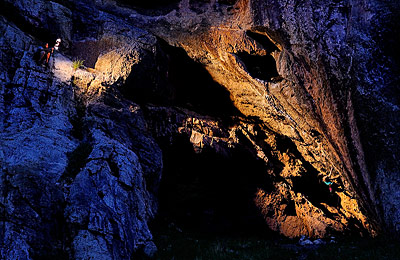 Image #5B Utah Ascent Set-Up … It was an easy scramble up some boulders and outcroppings for Taylor that only took about 3 minutes. A couple of test shots later I was ready for Lauren to begin her climb. Here again is my triangle arrangement with my 4 SB-900 Speedlights being about 50 feet from my subject, my subject is about 110 feet from me, and I am about 130 feet from my Speedlights. Image #5B Utah Ascent Set-Up … It was an easy scramble up some boulders and outcroppings for Taylor that only took about 3 minutes. A couple of test shots later I was ready for Lauren to begin her climb. Here again is my triangle arrangement with my 4 SB-900 Speedlights being about 50 feet from my subject, my subject is about 110 feet from me, and I am about 130 feet from my Speedlights. |
![]() Hi and welcome to this edition of Workshop at the Ranch. The learning continues this month as I pack up my gear and hit the road again in my quest to photograph Sports Acton with SB-900 Speedlights. With the success of Speedlighting kayaking on the Arkansas River I decided to stay with the adventure sport theme and reach for new heights. Climbing has always interested me and thanks to my good friend Keith Ladzinski (…you must check out his website at: www.ladzinski.com I have had the opportunity to get aquatinted with this amazing sport and the way he photographs it. Keith tends to stretch the limits when it comes to lighting climbers and so I turned to his experience and advise when making my arrangements to climb to higher ground regarding this next sports action with Speedlights project.
Hi and welcome to this edition of Workshop at the Ranch. The learning continues this month as I pack up my gear and hit the road again in my quest to photograph Sports Acton with SB-900 Speedlights. With the success of Speedlighting kayaking on the Arkansas River I decided to stay with the adventure sport theme and reach for new heights. Climbing has always interested me and thanks to my good friend Keith Ladzinski (…you must check out his website at: www.ladzinski.com I have had the opportunity to get aquatinted with this amazing sport and the way he photographs it. Keith tends to stretch the limits when it comes to lighting climbers and so I turned to his experience and advise when making my arrangements to climb to higher ground regarding this next sports action with Speedlights project. 










